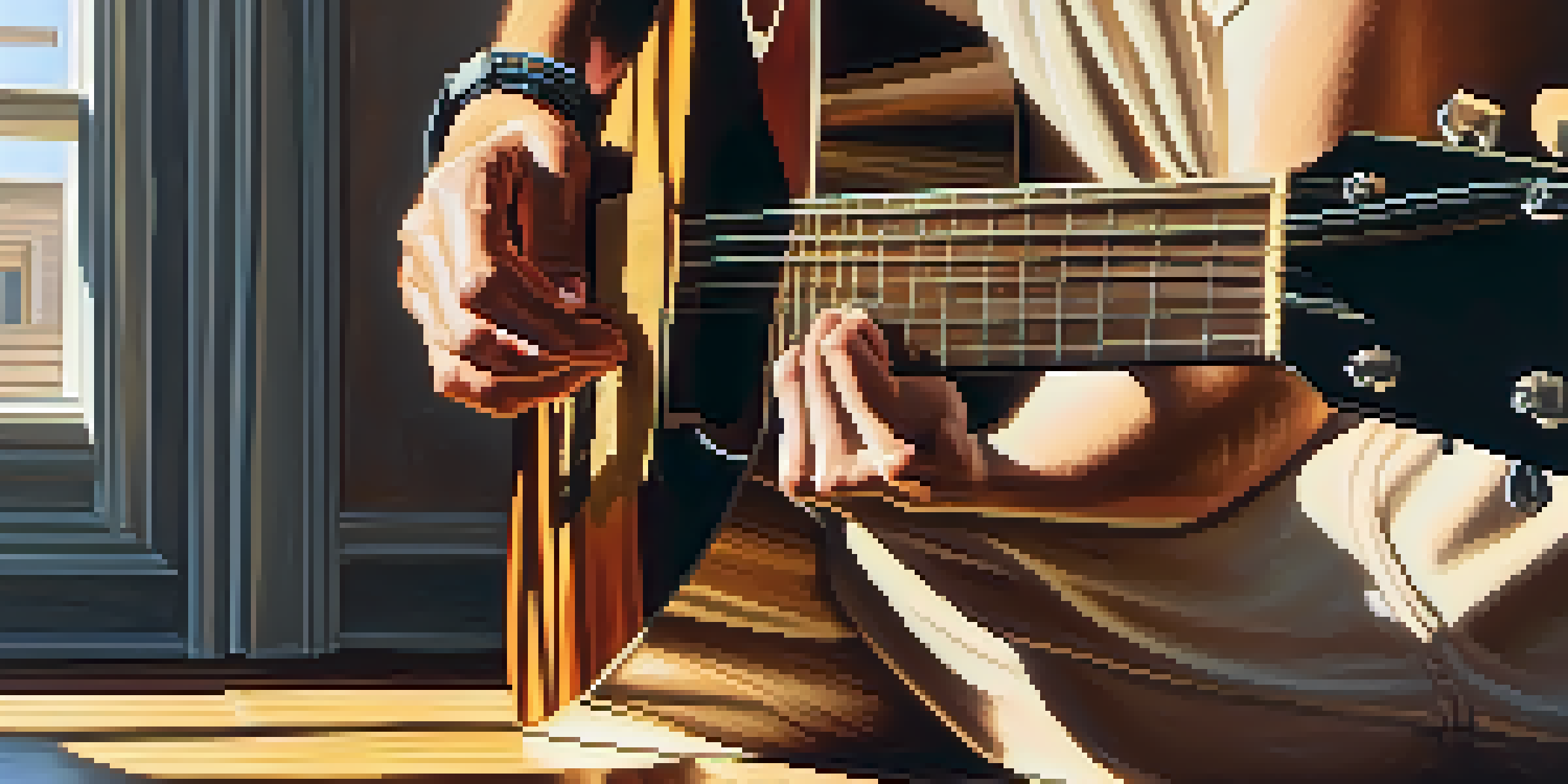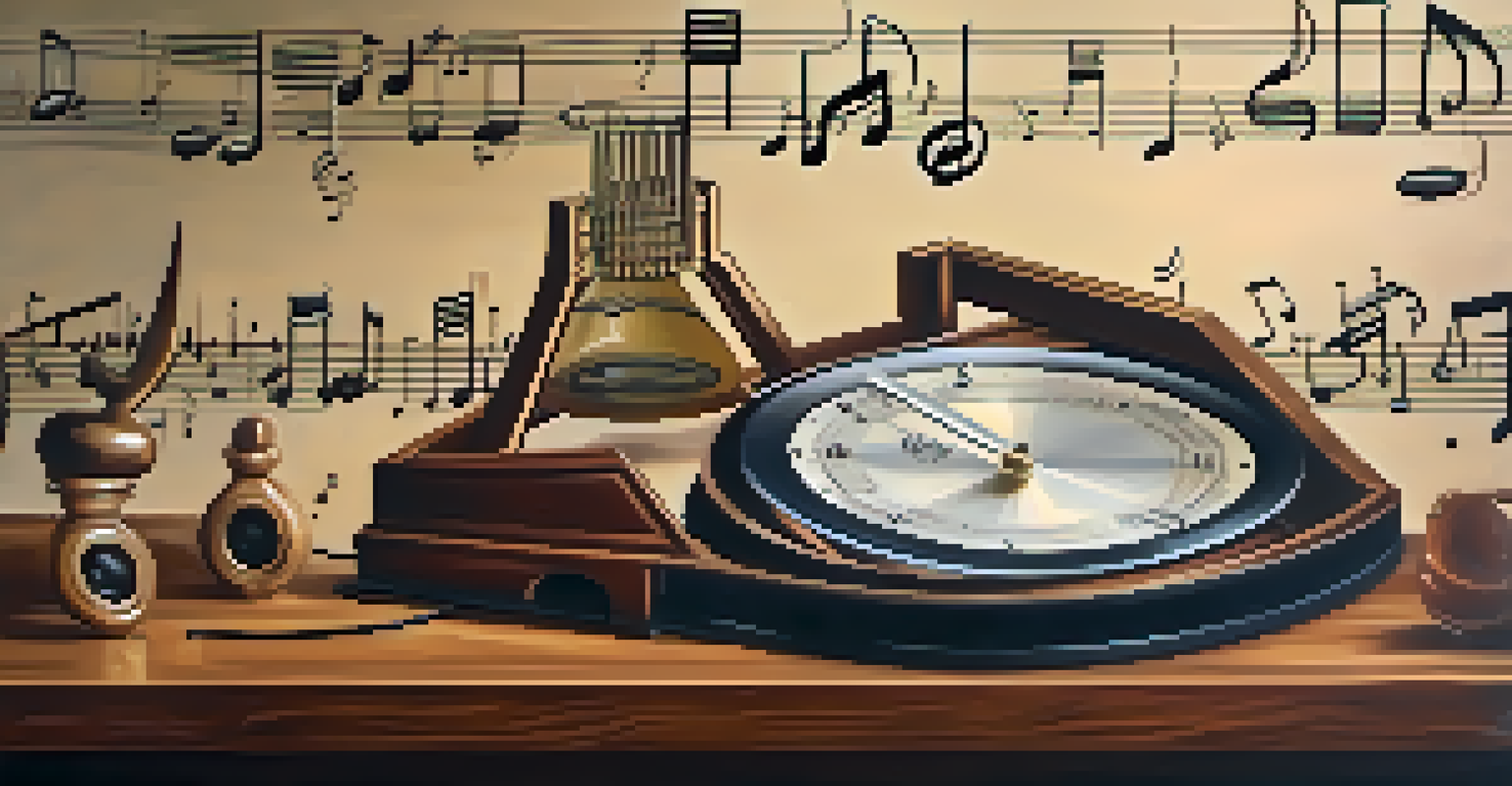Developing a Strong Sense of Rhythm for Guitar Performance

Understanding Rhythm: The Foundation of Music
Rhythm is often described as the heartbeat of music, providing the structure that supports melodies. Without a solid sense of rhythm, even the most skilled guitarists can struggle to create engaging performances. Think of rhythm as the framework of a house; it holds everything together and keeps it standing strong.
Rhythm is the backbone of the music; it gives it life and motion.
For guitarists, a strong rhythm is essential not just for playing in time but for enhancing the overall feel of a piece. Whether you're strumming chords or playing intricate solos, rhythm dictates how your music will be perceived. It’s what can transform a simple tune into something captivating and dynamic.
By developing your rhythmic skills, you’ll find that you can express yourself more freely on the guitar. You'll gain the ability to play with others seamlessly, making jam sessions more enjoyable and collaborative. In essence, mastering rhythm can elevate your entire musical experience.
The Importance of Timing in Guitar Playing
When it comes to guitar performance, timing is everything. It’s the difference between a note that resonates beautifully and one that feels off. Just like a well-timed joke lands with a punch, so does a note played in perfect time, creating a musical punch that captivates your audience.

To develop good timing, start by practicing with a metronome. This handy device ticks away at a steady pace, helping you internalize the beat. As you practice, gradually increase the tempo to challenge yourself, ensuring you maintain accuracy and precision at higher speeds.
Rhythm is the Heart of Music
A strong sense of rhythm provides the essential framework that enhances musical expression and engagement.
Remember, great guitarists aren’t just those who play fast; they are the ones who can make every note count. Strive to play in time consistently, and soon you’ll notice how timing enhances your ability to connect with your listeners, creating a more immersive experience.
Practicing with a Metronome: Tips and Tricks
Using a metronome can feel daunting at first, but it’s a game-changer for developing your rhythm. Start by setting it at a slow tempo and play simple patterns, focusing on hitting each note precisely with the click. Over time, you can increase the tempo, making sure your accuracy remains intact.
Timing is everything in music. Get it right, and you create magic.
One effective practice method is to play a scale or a chord progression while the metronome ticks away. This not only helps with timing but also builds muscle memory as you associate that steady beat with your finger movements. Think of it like training wheels for your rhythm; it keeps you balanced as you learn.
Don't hesitate to experiment with different subdivisions of the beat as well. For instance, practice playing eighth notes or triplets against the metronome to develop a more nuanced rhythmic feel. This will give you a wider range of rhythmic expression when performing, allowing your playing to shine.
Exploring Different Rhythmic Patterns
Rhythmic patterns are the colors of musical expression, enriching your guitar playing beyond basic chords. From syncopation to polyrhythms, exploring various patterns can add depth and excitement to your performance. Think of it as painting; each pattern adds a unique brushstroke to your musical canvas.
Start by learning some common rhythmic patterns, like the classic 'down-up' strumming technique or more complex fingerpicking styles. As you become comfortable, challenge yourself to incorporate these patterns into your favorite songs. This not only makes practice more enjoyable but also allows you to personalize your playing.
Timing Enhances Guitar Performance
Mastering timing allows guitarists to create captivating performances, transforming each note into a powerful musical statement.
Additionally, listening to different genres can inspire new rhythmic ideas. Whether it's jazz, rock, or folk, each style has its own signature rhythms. By immersing yourself in diverse musical worlds, you'll discover fresh patterns to incorporate into your guitar performance.
Playing Along with Your Favorite Songs
One of the best ways to develop a strong sense of rhythm is by playing along with songs you love. This exercise not only makes practice fun but also helps you internalize the rhythmic feel of different styles. Just like dancing along to a catchy tune, playing guitar with your favorite tracks can enhance your timing and groove.
Start with slower songs and gradually work your way up to faster tempos. Pay close attention to the drummer's rhythm, as the drums often lay the foundation for the song's groove. By matching your guitar playing to the rhythm section, you'll improve your ability to lock in with other musicians.
Consider using apps or software that allow you to slow down tracks without altering the pitch. This way, you can practice complex pieces at a manageable speed, ensuring you grasp the rhythmic nuances before speeding up. Over time, this practice will help you feel more confident and secure in your timing.
Jamming with Other Musicians for Rhythm Development
Jamming with other musicians is one of the most enjoyable ways to develop your rhythmic skills. It pushes you to listen closely and adapt to different playing styles, which enhances your overall musicianship. Think of it like a musical conversation; you learn to respond to the rhythm of others while adding your own voice.
When you play with other musicians, focus on locking in with their rhythm. This means not only keeping time but also feeling the groove of the group. The more you practice this, the more instinctive your rhythmic sense will become, allowing you to play with confidence and flair.
Jamming Builds Rhythmic Skills
Playing with other musicians fosters adaptability and strengthens your ability to lock in with different rhythmic styles.
Additionally, don't shy away from experimenting with different roles in the jam. Sometimes take the lead, while other times, support the rhythm section. This versatility will make you a more well-rounded musician and deepen your understanding of rhythm in various contexts.
The Role of Feel and Emotion in Rhythm
While mastering technical aspects of rhythm is crucial, don't forget the role of feel and emotion in your playing. Rhythm isn't just about hitting the right notes at the right time; it's also about conveying feelings and connecting with your audience. Think of it as the difference between reciting a poem and telling a story; it's all in how you deliver it.
To enhance the emotional aspect of your rhythm, pay attention to dynamics and accents. Emphasizing certain beats can create tension and release, making your performance more captivating. For instance, strumming more forcefully on the downbeat or softening your touch on the upbeat can add layers to your rhythm.

Ultimately, developing a strong sense of rhythm is about finding the balance between technique and expression. As you grow as a guitarist, remember to infuse your playing with your unique personality and emotions. This will elevate your performances, making them not only technically sound but also deeply resonant.